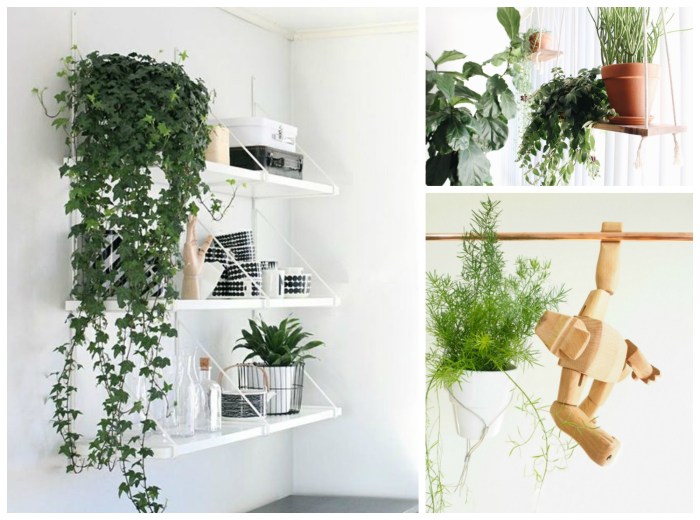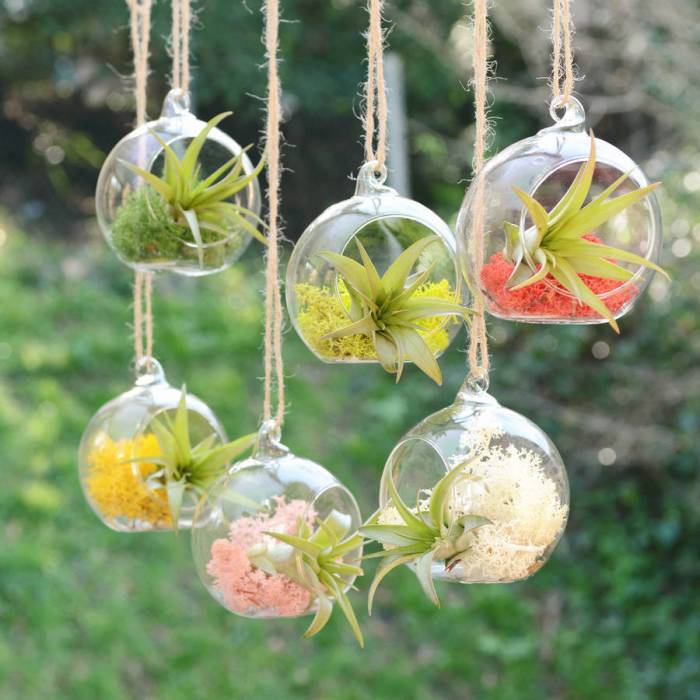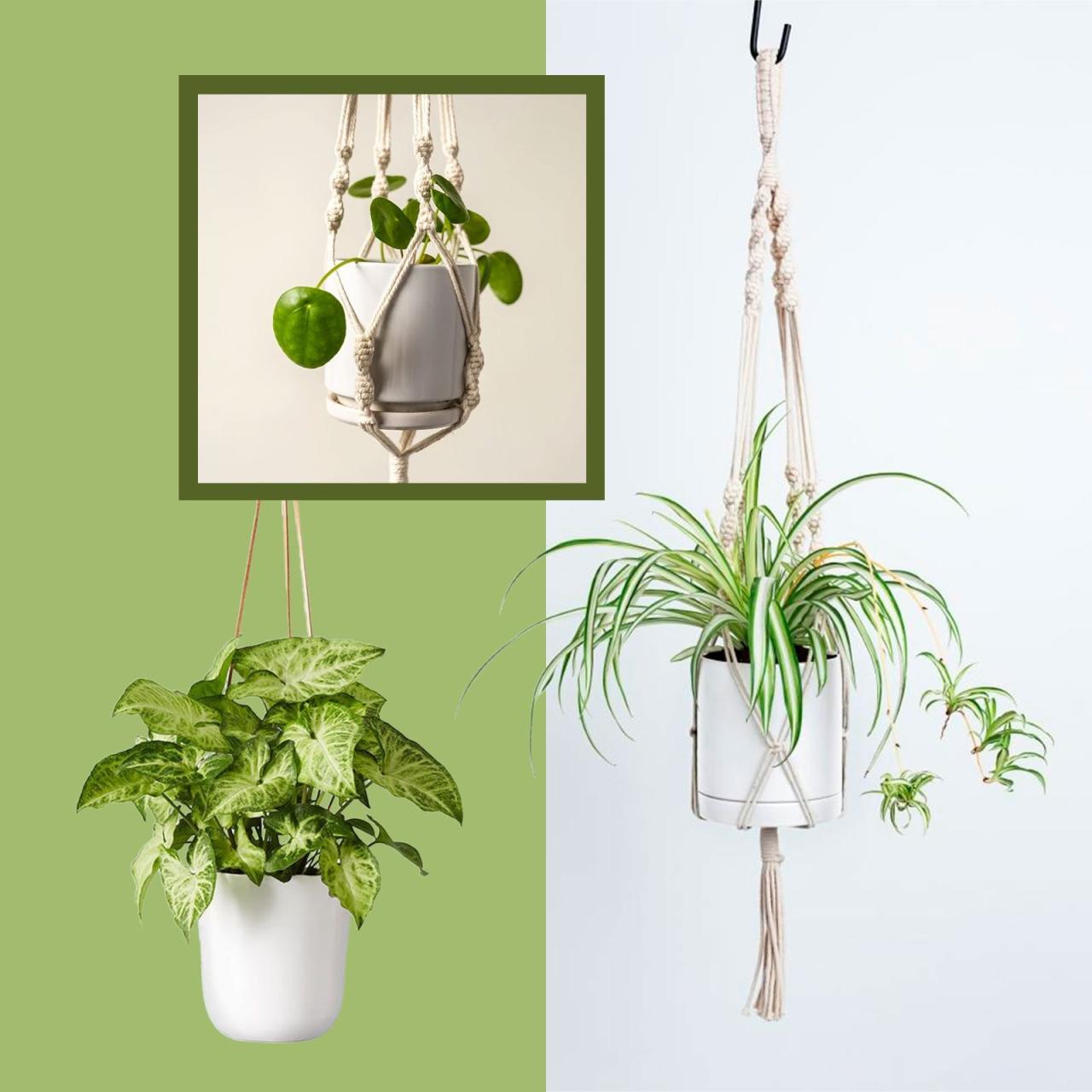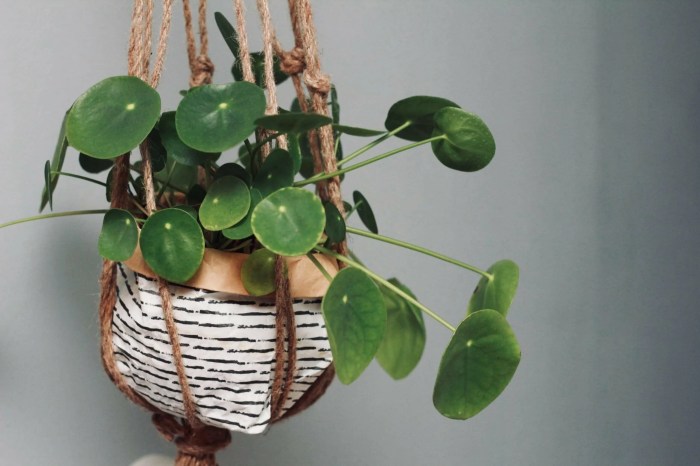Immerse yourself in the captivating world of hanging plants, where beauty and functionality intertwine. From lush greenery to air-purifying wonders, discover the coolest hanging plants that will transform your indoor spaces into vibrant oases.
With their cascading foliage and unique characteristics, hanging plants offer a myriad of benefits, enhancing both the aesthetics and well-being of your home. Whether you seek to brighten up a dimly lit corner or create a serene sanctuary, this guide will unveil the perfect hanging plants for every need.
Coolest Hanging Plants for Indoor Spaces

Hanging plants have become increasingly popular in indoor spaces, adding a touch of greenery and freshness to any room. With their cascading foliage and unique growth patterns, these plants create a sense of tranquility and add a touch of the outdoors to your living space.
When selecting hanging plants for your indoor space, it’s important to consider the size of the room, the amount of natural light available, and the level of care you’re willing to provide. Some plants thrive in bright, sunny spots, while others prefer indirect light or even shade.
Popular Hanging Plants
- Spider Plant (Chlorophytum comosum):Known for its long, arching leaves and spiderettes, spider plants are easy to care for and tolerate a wide range of light conditions.
- Pothos (Epipremnum aureum):Also known as Devil’s Ivy, pothos is a fast-growing vine with heart-shaped leaves that can vary in color from solid green to variegated. It’s tolerant of low light and infrequent watering.
- String of Pearls (Senecio rowleyanus):This unique plant features trailing stems with small, bead-like leaves that resemble pearls. It prefers bright, indirect light and well-draining soil.
- Burro’s Tail (Sedum morganianum):With its plump, fleshy leaves that resemble a donkey’s tail, burro’s tail is a charming and easy-care succulent. It thrives in bright, sunny spots and infrequent watering.
- Ferns (Nephrolepis exaltata):Ferns add a touch of elegance to any space with their delicate, feathery fronds. They prefer indirect light and high humidity, making them ideal for bathrooms or kitchens.
Benefits of Hanging Plants
In addition to their aesthetic appeal, hanging plants offer several benefits for indoor spaces:
- Improved Air Quality:Many hanging plants, such as spider plants and pothos, have the ability to purify the air by removing toxins and pollutants.
- Increased Humidity:Plants release moisture into the air through transpiration, which can help increase humidity levels in dry indoor spaces, benefiting both humans and plants.
- Stress Reduction:Studies have shown that being around plants can reduce stress and improve mood. The presence of hanging plants in a room can create a calming and inviting atmosphere.
Care Tips
To ensure the health and longevity of your hanging plants, follow these general care tips:
- Water Regularly:Water your plants when the soil feels dry to the touch, but avoid overwatering.
- Provide Adequate Light:Choose a hanging location that receives the appropriate amount of light for the plant’s needs.
- Fertilize Monthly:Fertilize your plants monthly during the growing season to provide essential nutrients.
- Prune Regularly:Trim any dead or damaged leaves and stems to maintain the plant’s health and appearance.
Hanging Plants for Low-Light Conditions

Indoor spaces often have areas with limited natural light, making it challenging to keep plants thriving. However, certain hanging plants have adapted to flourish in these low-light environments.These plants possess unique mechanisms to maximize light absorption and utilization. Their leaves are often broad and thin, allowing them to capture more light.
Some species have variegated foliage, with lighter-colored sections that reflect light more effectively.
Caring for Low-Light Hanging Plants
To ensure the health and growth of low-light hanging plants, proper care is essential. Water sparingly, allowing the soil to dry out slightly between waterings. Overwatering can lead to root rot. Use well-draining potting mix to prevent waterlogging.Fertilize monthly during the growing season with a balanced liquid fertilizer.
Avoid over-fertilizing, as it can damage the plant. Provide humidity by misting the plant regularly or placing it on a pebble tray filled with water.
Recommended Low-Light Hanging Plants, Coolest hanging plants
| Plant | Light Requirements | Maintenance Needs |
|---|---|---|
| Snake Plant (Sansevieria trifasciata) | Low to medium | Low |
| ZZ Plant (Zamioculcas zamiifolia) | Low to medium | Very low |
| Pothos (Epipremnum aureum) | Low to medium | Low |
| Peace Lily (Spathiphyllum wallisii) | Low to medium | Medium |
| Chinese Evergreen (Aglaonema) | Low | Low |
Hanging Plants for Small Spaces

For those with limited space, hanging plants are a stylish and space-saving solution. These compact plants thrive in vertical environments, adding greenery and a touch of nature without taking up precious floor space.
If you’re looking for the coolest hanging plants to add some life to your home, you’ll want to check out our list of the best trailing plants for pots. These plants are perfect for adding a touch of greenery to any room, and they’re also easy to care for.
Whether you’re a beginner or an experienced plant parent, you’re sure to find the perfect plant for your home on our list of best trailing plants for pots . So what are you waiting for? Start browsing today and find the perfect plant to add to your home.
To maximize vertical space, consider using macrame hangers, wall-mounted planters, or cascading pots. These methods allow you to create lush plant displays without cluttering the room.
For those seeking the coolest hanging plants, a plethora of options await. From the cascading leaves of the pothos to the intricate patterns of the string of hearts, these verdant wonders add a touch of elegance to any space. However, when selecting the best indoor plants for hanging pots, it’s essential to consider factors such as light requirements, watering frequency, and overall size.
Fortunately, a comprehensive guide to best indoor plants for hanging pots is available online, providing valuable insights and recommendations for creating a lush and captivating indoor oasis with the coolest hanging plants.
Suitable Hanging Plants
- String of Pearls (Senecio rowleyanus):This trailing succulent forms long, bead-like stems that cascade beautifully over the edges of planters.
- Spider Plant (Chlorophytum comosum):With its long, arching leaves, the spider plant adds a touch of elegance to any space. It produces small plantlets that can be easily propagated.
- Burro’s Tail (Sedum morganianum):This succulent has plump, trailing stems that resemble a burro’s tail. Its compact growth habit makes it ideal for hanging baskets.
- Trailing Jade (Senecio mandraliscae):A trailing succulent with small, rounded leaves, the trailing jade brings a touch of greenery to small spaces.
- Heartleaf Philodendron (Philodendron scandens):This fast-growing vine has heart-shaped leaves that cascade gracefully over the sides of pots.
Hanging Plants for Air Purification

Hanging plants are not just decorative additions to your home; they can also be powerful air purifiers. Certain plants have the ability to remove harmful toxins and improve indoor air quality, creating a healthier living environment for you and your family.
With their trailing vines and lush foliage, the coolest hanging plants bring a touch of the outdoors in. Whether you’re looking to add a pop of color or create a serene atmosphere, there’s a hanging plant perfect for your home.
If you’re not sure where to start, consider popular choices like the pothos, spider plant, or string of pearls. To find the best selection and buy indoor hanging plants online, check out our guide to the coolest hanging plants.
These plants work by absorbing pollutants through their leaves and roots. They then break down these toxins and release clean oxygen back into the air. Some plants are particularly effective at removing specific pollutants, such as formaldehyde, benzene, and trichloroethylene.
Effectiveness of Hanging Plants for Air Purification
The effectiveness of hanging plants for air purification depends on several factors, including the type of plant, the size of the plant, and the amount of sunlight it receives. However, research has shown that even a small number of plants can make a significant difference in indoor air quality.
| Plant | Pollutants Removed | Optimal Placement |
|---|---|---|
| Spider Plant | Formaldehyde, benzene, trichloroethylene | Bright indirect light |
| Peace Lily | Formaldehyde, benzene, ammonia | Low light |
| Snake Plant | Formaldehyde, benzene, trichloroethylene, xylene | Bright indirect light or low light |
| Golden Pothos | Formaldehyde, benzene, trichloroethylene, xylene | Bright indirect light or low light |
| Chinese Evergreen | Formaldehyde, benzene, trichloroethylene | Low light |
To maximize the air-purifying benefits of hanging plants, place them in areas where you spend the most time, such as your living room, bedroom, or office. You can also group several plants together to create a more effective air-purifying system.
Hanging Plants for Pet-Friendly Homes: Coolest Hanging Plants
Hanging plants can bring a touch of nature and freshness to your home, but if you have pets, it’s important to choose plants that are safe and non-toxic.
Some common hanging plants that are safe for pets include:
Spider Plants
- Spider plants are non-toxic to both cats and dogs.
- They are also easy to care for, making them a good choice for busy pet owners.
- Spider plants can help to purify the air, removing toxins like formaldehyde and xylene.
Air Plants
- Air plants are non-toxic to both cats and dogs.
- They do not require soil, making them a good choice for homes with pets that like to dig.
- Air plants can help to improve air quality by removing pollutants.
Ferns
- Most ferns are non-toxic to both cats and dogs.
- They prefer indirect light and moist soil, making them a good choice for homes with pets that are not very active.
- Ferns can help to add humidity to the air, which can be beneficial for pets with respiratory problems.
It is always important to do your research before bringing any new plant into your home, especially if you have pets. Some plants, such as lilies and azaleas, can be toxic to pets, so it is best to avoid them.
Closure

As you embark on your journey to incorporate hanging plants into your living spaces, remember that these verdant companions require care and attention to thrive. By understanding their specific needs and providing optimal conditions, you can cultivate a thriving indoor jungle that will bring joy and tranquility for years to come.
FAQ
What are the most popular hanging plants for indoor spaces?
Some of the most popular hanging plants for indoor environments include pothos, spider plants, philodendrons, and ferns.
Which hanging plants are best for low-light conditions?
Hanging plants that thrive in low-light areas include snake plants, ZZ plants, and peace lilies.
What hanging plants are ideal for small spaces?
Compact hanging plants suitable for small spaces include string of pearls, air plants, and peperomias.
Which hanging plants are effective for air purification?
Hanging plants that possess air-purifying capabilities include spider plants, peace lilies, and snake plants.
What hanging plants are safe for pet-friendly homes?
Pet-friendly hanging plants include spider plants, air plants, and ferns.